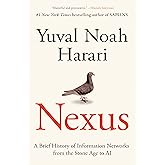
Enjoy fast, free delivery, exclusive deals, and award-winning movies & TV shows with Prime
Try Prime
and start saving today with fast, free delivery
Amazon Prime includes:
Fast, FREE Delivery is available to Prime members. To join, select "Try Amazon Prime and start saving today with Fast, FREE Delivery" below the Add to Cart button.
Amazon Prime members enjoy:- Cardmembers earn 5% Back at Amazon.com with a Prime Credit Card.
- Unlimited Free Two-Day Delivery
- Streaming of thousands of movies and TV shows with limited ads on Prime Video.
- A Kindle book to borrow for free each month - with no due dates
- Listen to over 2 million songs and hundreds of playlists
- Unlimited photo storage with anywhere access
Important: Your credit card will NOT be charged when you start your free trial or if you cancel during the trial period. If you're happy with Amazon Prime, do nothing. At the end of the free trial, your membership will automatically upgrade to a monthly membership.

Download the free Kindle app and start reading Kindle books instantly on your smartphone, tablet, or computer - no Kindle device required.
Read instantly on your browser with Kindle for Web.
Using your mobile phone camera - scan the code below and download the Kindle app.



 Audible sample
Audible sample Follow the author
OK
Why Machines Learn: The Elegant Math Behind Modern AI Hardcover – July 16, 2024

Explore your book, then jump right back to where you left off with Page Flip.
View high quality images that let you zoom in to take a closer look.
Enjoy features only possible in digital – start reading right away, carry your library with you, adjust the font, create shareable notes and highlights, and more.
Discover additional details about the events, people, and places in your book, with Wikipedia integration.
Purchase options and add-ons
Machine learning systems are making life-altering decisions for us: approving mortgage loans, determining whether a tumor is cancerous, or deciding if someone gets bail. They now influence developments and discoveries in chemistry, biology, and physics—the study of genomes, extrasolar planets, even the intricacies of quantum systems. And all this before large language models such as ChatGPT came on the scene.
We are living through a revolution in machine learning-powered AI that shows no signs of slowing down. This technology is based on relatively simple mathematical ideas, some of which go back centuries, including linear algebra and calculus, the stuff of seventeenth- and eighteenth-century mathematics. It took the birth and advancement of computer science and the kindling of 1990s computer chips designed for video games to ignite the explosion of AI that we see today. In this enlightening book, Anil Ananthaswamy explains the fundamental math behind machine learning, while suggesting intriguing links between artificial and natural intelligence. Might the same math underpin them both?
As Ananthaswamy resonantly concludes, to make safe and effective use of artificial intelligence, we need to understand its profound capabilities and limitations, the clues to which lie in the math that makes machine learning possible.
- Print length480 pages
- LanguageEnglish
- PublisherDutton
- Publication dateJuly 16, 2024
- Dimensions6.2 x 1.52 x 9.24 inches
- ISBN-100593185749
- ISBN-13978-0593185742
Frequently bought together

Customers who viewed this item also viewed
Editorial Reviews
Review
“Why Machines Learn, by the award-winning science writer Anil Ananthaswamy, takes the reader on an entertaining journey into the mind of a machine… [The book] demystifies the underlying mechanisms behind machine learning, which may possibly lead to a better understanding of the learning process itself and the development of improved AI.”
—Physics World
“A skillful primer makes sense of the mathematics beneath AI's hood.”
—New Scientist
“Whether Ananthaswamy is talking of ML algorithms or manipulation of matrices, he maintains a lightness of language and invokes historical accounts to advance a compelling narrative… A must-read for anyone who is curious to understand "the elegant math behind modern AI" [and] an inspirational guide for teachers of math and mathematical sciences who can adopt these techniques and methods to make classrooms lively.”
—Shaastra, IIT-Madras
“Some books about the development of neural networks describe the underlying mathematics while others describe the social history. This book presents the mathematics in the context of the social history. It is a masterpiece. The author is very good at explaining the mathematics in a way that makes it available to people with only a rudimentary knowledge of the field, but he is also a very good writer who brings the social history to life.”
—Geoffrey Hinton, deep learning pioneer, Turing Award winner, former VP at Google, and Professor Emeritus at University of Toronto
“After just a few minutes of reading Why Machines Learn, you’ll feel your own synaptic weights getting updated. By the end you will have achieved your own version of deep learning—with deep pleasure and insight along the way.”
—Steven Strogatz, New York Times bestselling author of Infinite Powers and professor of mathematics at Cornell University
“If you were looking for a way to make sense of the AI revolution that is well underway, look no further. With this comprehensive yet engaging book, Anil Ananthaswamy puts it all into context, from the origin of the idea and its governing equations to its potential to transform medicine, quantum physics—and virtually every aspect of our life. An essential read for understanding both the possibilities and limitations of artificial intelligence.”
—Sabine Hossenfelder, physicist and New York Times bestselling author of Existential Physics: A Scientist's Guide to Life's Biggest Questions
“Why Machines Learn is a masterful work that explains—in clear, accessible, and entertaining fashion—the mathematics underlying modern machine learning, along with the colorful history of the field and its pioneering researchers. As AI has increasingly profound impacts in our world, this book will be an invaluable companion for anyone who wants a deep understanding of what’s under the hood of these often inscrutable machines.”
—Melanie Mitchell, author of Artificial Intelligence and Professor at the Santa Fe Institute
“Generative AI, with its foundations in machine learning, is as fundamental an advance as the creation of the microprocessor, the Internet, and the mobile phone. But almost no one, outside of a handful of specialists, understands how it works. Anil Ananthaswamy has removed the mystery by giving us a gentle, intuitive, and human-oriented introduction to the math that underpins this revolutionary development.”
—Peter E. Hart, AI pioneer, entrepreneur, and co-author of Pattern Classification
“Anil Ananthaswamy’s Why Machines Learn embarks on an exhilarating journey through the origins of contemporary machine learning. With a captivating narrative, the book delves into the lives of influential figures driving the AI revolution while simultaneously exploring the intricate mathematical formalism that underpins it. As Anil traces the roots and unravels the mysteries of modern AI, he gently introduces the underlying mathematics, rendering the complex subject matter accessible and exciting for readers of all backgrounds.”
—Björn Ommer, Professor at the Ludwig Maximilian University of Munich and leader of the original team behind Stable Diffusion
“An inspiring introduction to the mathematics of AI.”
—Arthur I. Miller, author of The Artist in the Machine: The World of AI-Powered Creativity
“[An] illuminating overview of how machine learning works.”
—Kirkus Reviews
About the Author
Excerpt. © Reprinted by permission. All rights reserved.
Desperately Seeking Patterns
When he was a child, the Austrian scientist Konrad Lorenz, enamored by tales from a book called The Wonderful Adventures of Nils-the story of a boy's adventures with wild geese written by the Swedish novelist and winner of the Nobel Prize for Literature, Selma Lagerlöf-"yearned to become a wild goose." Unable to indulge his fantasy, the young Lorenz settled for taking care of a day-old duckling his neighbor gave him. To the boy's delight, the duckling began following him around: It had imprinted on him. "Imprinting" refers to the ability of many animals, including baby ducks and geese (goslings), to form bonds with the first moving thing they see upon hatching. Lorenz would go on to become an ethologist and would pioneer studies in the field of animal behavior, particularly imprinting. (He got ducklings to imprint on him; they followed him around as he walked, ran, swam, and even paddled away in a canoe.) He won the Nobel Prize for Physiology or Medicine in 1973, jointly with fellow ethologists Karl von Frisch and Nikolaas Tinbergen. The three were celebrated "for their discoveries concerning organization and elicitation of individual and social behavior patterns."
Patterns. While the ethologists were discerning them in the behavior of animals, the animals were detecting patterns of their own. Newly hatched ducklings must have the ability to make out or tell apart the properties of things they see moving around them. It turns out that ducklings can imprint not just on the first living creature they see moving, but on inanimate things as well. Mallard ducklings, for example, can imprint on a pair of moving objects that are similar in shape or color. Specifically, they imprint on the relational concept embodied by the objects. So, if upon birth the ducklings see two moving red objects, they will later follow two objects of the same color (even if those latter objects are blue, not red), but not two objects of different colors. In this case, the ducklings imprint on the idea of similarity. They also show the ability to discern dissimilarity. If the first moving objects the ducklings see are, for example, a cube and a rectangular prism, they will recognize that the objects have different shapes and will later follow two objects that are different in shape (a pyramid and a cone, for example), but they will ignore two objects that have the same shape.
Ponder this for a moment. Newborn ducklings, with the briefest of exposure to sensory stimuli, detect patterns in what they see, form abstract notions of similarity/dissimilarity, and then will recognize those abstractions in stimuli they see later and act upon them. Artificial intelligence researchers would offer an arm and a leg to know just how the ducklings pull this off.
While today's AI is far from being able to perform such tasks with the ease and efficiency of ducklings, it does have something in common with the ducklings, and that's the ability to pick out and learn about patterns in data. When Frank Rosenblatt invented the perceptron in the late 1950s, one reason it made such a splash was because it was the first formidable "brain-inspired" algorithm that could learn about patterns in data simply by examining the data. Most important, given certain assumptions about the data, researchers proved that Rosenblatt's perceptron will always find the pattern hidden in the data in a finite amount of time; or, put differently, the perceptron will converge upon a solution without fail. Such certainties in computing are like gold dust. No wonder the perceptron learning algorithm created such a fuss.
But what do these terms mean? What are “patterns” in data? What does “learning about these patterns” imply?
Product details
- Publisher : Dutton (July 16, 2024)
- Language : English
- Hardcover : 480 pages
- ISBN-10 : 0593185749
- ISBN-13 : 978-0593185742
- Item Weight : 2.31 pounds
- Dimensions : 6.2 x 1.52 x 9.24 inches
- Best Sellers Rank: #3,640 in Books (See Top 100 in Books)
- Customer Reviews:
About the author

ANIL ANANTHASWAMY is former deputy news editor and current consultant for New Scientist. He is a guest editor at UC Santa Cruz’s science-writing program and teaches an annual science journalism workshop at the National Centre for Biological Sciences in Bangalore, India. He is a freelance feature editor for the Proceedings of the National Academy of Science’s “Front Matter” and has written for National Geographic News, Discover, and Matter. He has been a columnist for PBS NOVA’s The Nature of Reality blog. He won the UK Institute of Physics’ Physics Journalism award and the British Association of Science Writers’ award for Best Investigative Journalism. His first book, The Edge of Physics, was voted book of the year in 2010 by Physics World.
Customer reviews
Customer Reviews, including Product Star Ratings help customers to learn more about the product and decide whether it is the right product for them.
To calculate the overall star rating and percentage breakdown by star, we don’t use a simple average. Instead, our system considers things like how recent a review is and if the reviewer bought the item on Amazon. It also analyzed reviews to verify trustworthiness.
Learn more how customers reviews work on AmazonCustomers say
Customers find the book informative, entertaining, and worthwhile. They say it touches on interesting pieces of math and asks good questions about the nature of intelligence. Readers also appreciate the compelling storytelling and personal writing style.
AI-generated from the text of customer reviews
Customers find the book informative, entertaining, and worthwhile. They say it touches on some interesting pieces of math that many newer people in the field don't know. Readers also appreciate the author's good questions about the nature of intelligence and how AI works. They mention the book provides a great look into the story of machine learning and a good approach to its math.
"...It's not too technical but also touches on some interesting pieces of math that many newer people in the field might have missed...." Read more
"...It's informative, entertaining, enriching, and worthwhile. No part of this book gets stale. It's a real win." Read more
"...me I found the historical aspect greatly simplified and aided my mathematical understanding...." Read more
"...Finally he asks very good questions about the nature of intelligence and how AI does or does not overlap with human intelligence, and well as the..." Read more
Customers find the philosophical aspects of the book wrapped in compelling storytelling. They say the history part is written in a very personal and engaging way.
"...methods and SVMs etc, but that section of the book was actually quite exciting and gave me more appreciation for this part of the field, for..." Read more
"...And, it's incredible because of that.It's a wonderfully-written narrative of the history of the people and their thought processes for..." Read more
"...That's the history part, written in a very personal and engaging way that only a good writer can do...." Read more
-
Top reviews
Top reviews from the United States
There was a problem filtering reviews right now. Please try again later.
Highly recommended!
It's a wonderfully-written narrative of the history of the people and their thought processes for developing the core ideas and then implementing them mathematically to bring about the practice of ML.
It's informative, entertaining, enriching, and worthwhile. No part of this book gets stale. It's a real win.
I’ve been hooked on the wonders of conversational Generative AI, both its productivity and knowledge boosts using LLMs and Chatbots such as ChatGPT (granted watchful of probabilisitic hallucinations) , but the math? Not so much.
My rusty dated college math tended to hold me back until this book cleared things up—historical context and all. Somewhat surprisingly to me I found the historical aspect greatly simplified and aided my mathematical understanding.
I’ll admit, I had to utilize AI chatbot assistants for backup a few times and also I purchased the audio book as well to refresh my prior readings, but that’s part of the fun, right?
If you’re curious about what makes machines learn and aren’t afraid to dust off some math, this book is your guide!
The way the author maintains the big picture while leading the reader through a "live" minute-by-minute narration of compelling details reminds me of the style of VS Naipal, despite being a completely different genre.
Ananthaswamy provides a history of the development of the field intertwined with the math in a way that provides a grounded, contextual understanding of what is going on. While the concepts are sophisticated, at no point did I feel lost or uninterested.
Anybody who has completed high school Precalculus should be able to handle most of the math in the book, with careful reading.
Really cannot recommend this book highly enough - it really is excellent.
Top reviews from other countries
Since I read Anil's book I've started reading Kevin Murphy's Probabilistic Machine Learning: An Introduction and I have to say it would have been impossible to get past chapter one without Anil's excellent introduction.














